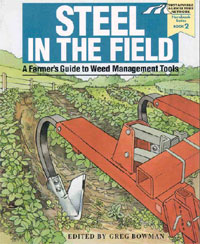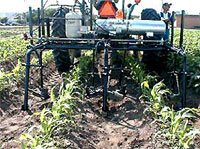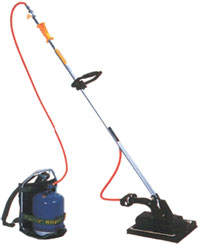skip
navigation  |
800-411-3222 (Español)
Flame Weeding for Vegetable Crops |
| By Steve
Diver NCAT Agriculture Specialist Published 2002 ATTRA Publication #CT165 |
The
printable PDF version of the entire document is available
at: http://attra.ncat.org/attra-pub/PDFflameweedveg.pdf 16 pages — 649K Download Acrobat Reader |
AbstractFlame weeding, a thermal weed control, uses propane gas burners to produce a carefully controlled and directed flame that briefly passes over weeds, searing the leaves and causing the weed to wilt and die. Flame weeding, as a non-chemical weed management technique, is frequently used by organic farmers. This publication discusses different strategies for pre-emergent flame weeding and post-emergent flame weeding, as well as infra-red weed control, and steam and hot water weed control. Further references, including sources of information and equipment, are also provided. Table of Contents
IntroductionFlame weeding — a type of thermal weed control — was commonly used in row crops like cotton and sorghum from the late 1930s until the mid-1960s, when selective herbicides became widely available. In the 1980s and ’90s, flame weeding made a rapid comeback as a non-chemical weed control technique, especially among organic farmers. Flame weeding, also called flame cultivation, relies on propane gas burners to produce a carefully controlled and directed flame that briefly passes over the weeds. The intense heat sears the leaf, causing the cell sap to expand and disrupt cell walls. Foliage that retains a thumb print when pressure is applied between your thumb and finger has been adequately flamed. The flamed weeds soon wilt and die, usually in one to three days. Weeds are most susceptible to flaming when they are seedlings, 1 or 2 inches tall. Broadleaf weeds are more susceptible to lethal flaming than grasses. Grasses develop a protective sheath by the time they are approximately 1 inch tall and may require a second flaming. Repeated flaming can likewise be used to suppress perennial weeds such as field bindweed. Flame weeders come in a range of human- and tractor-powered models. Market-farming equipment options include handheld single-torch flamers, as well as push-wheeled multiple-torch flamers mounted under a flame hood. Tractor-powered kits are available in 2, 4, 6, and 8-row models, with or without a flame hood; other options include a complete toolbar setup with accompanying cultivator attachments for between-row mechanical cultivation. Farmer feedback on flame weeding has been positive. Joe Fitzgerald, a farmer near Dubuque, Iowa, reported that “a blind person can see the difference in weed control” between flamed and unflamed organic corn, even though both plots had also been rotary-hoed and cultivated. (1) Pre-emergent Flaming
Stale Seedbed TechniqueThe stale seedbed technique is a form of early-season weed control in direct-seeded crops. Seedbed preparation and soil stirring — for example, hilling the soil into beds — always results in a flush of weeds. With this technique, instead of sowing vegetable seeds into freshly prepared soil, planting is delayed. The aim is to knock down the early-germinating weeds, and perhaps a second flush of weeds, without further soil tillage (which would bring new weed seeds to the surface).The vegetable crop is then seeded into a weed-free bed. Most often, shallow tillage or herbicides are used to knock down the flush of weeds, but flaming is an alternative technique. Growers will sometimes pre-irrigate to induce more weed growth before flaming.
This technique can also be used to prepare a stale seedbed prior to setting out transplants. Essentially, you are helping your vegetable crops get off to a good start by eliminating early-season weed competition. Once the vegetable canopy forms, shade reduces weed germination; weed seedlings that do sprout can be controlled by mechanical cultivation. The critical weed-free period is the minimum length of time a crop must remain nearly weed-free to prevent reductions in yield or quality. For most vegetables, this is usually the first quarter or third of their growing period — something like four to six weeks after seedling emergence, and slightly less for transplants. Weeds emerging after this period have less impact on vegetable yields than early-season weeds.
Peak Emergence TechniqueIn the peak-emergence flaming technique, vegetable seeds are promptly sown after seedbed preparation. Just before vegetable seedlings emerge, the bed is flamed to kill seedling weeds (which tend to sprout faster). The aim is to eliminate the first flush of weeds and catch the seedling weeds when they are young and susceptible, while avoiding damage to the vegetable crop. (2, 3)
This second method is especially well suited to slow-germinating, direct-seeded crops like carrots and parsnips. At optimum soil temperatures, carrots germinate approximately seven to eight days after planting. In this case, weeds would be flamed off after five or six days. However, carrots are commonly planted in cool soils and germination may take as long as 14 to 21 days. Consequently, it’s best to dig into the row to check on the progress of seedlings and time the flaming accordingly. Some growers place a pane of glass or plastic strip over a small section of the bed to speed up carrot seed germination. The field is flamed when the carrots under the glass emerge. The rationale is that the carrots in bare soil will typically emerge a few days later. In European trials, flaming alone reduced weed populations in carrot beds by 80 percent. (3) As carrots are particularly difficult to weed, this technique is a real boost to organic farmers. Steve Meyer, a market gardener in West Virginia who flames carrots, onions, and beets, said, “The difference in weed control between flamed and unflamed beds is like night and day.” (4) Following flaming, and for the duration of the growing season, a mechanical weed-control system can be used for carrots, employing specialized cultivators (finger weeders, inter-row brush hoes, steerage hoes) or standard cultivators and wheel hoes. Refer to Steel in the Field: A Farmer’s Guide to Weed Management Tools, a practical handbook from the Sustainable Agriculture Network, for descriptions and illustrations of mechanical cultivation tools. (5) The following table shows the approximate number of days to carrot seedling emergence at various soil temperatures, when seeds are planted ½ inch deep.
To increase the effectiveness of flame weeding on vegetable beds for carrots and other direct-seeded crops, Thermal Weed Control Systems, Inc. of Neillsville, Wisconsin, offers a flame hood similar to those used in Europe. Ron Jones of Thermal Weed Control Systems calls it a “hover burner.” The tractor-drawn models he manufactures have 5 to 7 burners, and cost in the neighborhood of $2,250. Jones explained that lettuce growers are also using the hover burner between sequential crop plantings to control insect and disease problems. Flame Weeders, a small company in West Virginia, manufactures push-flamers for market farmers that are wheel-mounted with flaming hoods; these range in price from $300 to $400.
Post-emergent FlamingFlame weeding can be applied after the vegetable crop has emerged by directing the flame away from the crop plants, by shielding the crop, or by flaming at a time when crop stems are resistant to heat. This method is also known as “selective flaming.” Directing flames into the crop row is a scary thought, but some plants can withstand the heat, especially after they’ve put on sufficient vegetative growth. The result is a non-chemical means of in-row weed control; for organic farmers, this is a significant tool. For example, see the pictures on flame weeding for corn at Reducing Herbicide Usage on the Farm, a joint project of Agricultural Utilization Research Institute (AURI) and Sustainable Farming Association of Minnesota (SFA). Reports from the literature include the following examples:
Cross FlamingCross flaming is one of several methods that can be used to flame weeds in emerged crops. Burners are placed at an angle on either side of the row, in a staggered pattern so that the combined flames cover the entire drill row area. Setting burners directly opposite each other should be avoided, since this can create turbulence and cause flames to boil up and damage crop leaves. During treatment, flames blow through the base of the crop, selectively killing weeds within the row without damaging the relatively heat-tolerant crop stems. Flames do not come in direct contact with crop foliage. The specific flaming angle, flaming pattern, and flame length vary with the manufacturer’s recommendations, but range from 30° to 40°, at 8 to 12 inches above the base of the plants, with flame lengths of approximately 12 to 15 inches. It is easiest to adjust the flame at night, when the flame path can be seen most clearly. Some experimentation will be necessary to determine the appropriate ground speed for each crop and situation. Weed density, the age of the weeds, and weather conditions affect flaming results. Ground speeds can range from 3 to 5 miles per hour. Parallel Flaming
Parallel flaming is a technique used to control weeds close to the rows for crops that are small or cannot tolerate cross-flaming. In this method, burners are set parallel to the direction of the crop row. A crop shield is sometimes employed to protect the crop. Cross-flaming and parallel-flaming rigs are often combined with mechanical cultivators to control weeds between the rows. Mechanical implements may include tines, sweeps, or rolling cultivators. Middle FlamingA third method of post-emergent flaming is middle flaming. Two burners are installed under a lightweight hood that covers the row middles. The hood directs the flames to the weeds in the row middles while protecting the adjacent crop foliage. Water-shielded FlamingWater-shielded flaming is a technique that was developed for use on cotton farms in the Mississippi Delta. Water nozzles are placed on the flame rig to direct fans of water onto the crop plant for extra protection. Infrared Weed ControlInfrared weeders—first developed in Europe—are heated by a propane torch, but the flame is directed toward a ceramic element or steel plate that radiates at temperatures of 1800 to 2000 °F. The danger associated with an open flame is thereby minimized. The mechanism of weed control is the same as in flame weeding; cell contents—plasma and proteins—are disrupted and the plant wilts down and dies. Infrared heaters are available in handheld, push-wheeled, and tractor-mounted models. In addition to weeding, the tractor-mounted infrared thermal units are used to control Colorado potato beetle and potato vine desiccation. Some of the tractor models feature the injection of forced air to increase the effect.
In North America, a line of Swiss-made infrared weeders are available through two companies: Forevergreen and Rittenhouse (see Further Resources below). These range from handheld to push-wheeled models suited to gardening, landscaping, nurseries, municipalities, and market farming. The handheld and push-wheeled infrared weeders appropriate for market farming are available in the $900 to $1,200 range. While infrared weeders appear to be a promising new thermal weed control tool, the equipment expense remains prohibitive for many smaller-scale market farmers. By comparison, a push-wheeled flame weeder is $300–$400. Steam + Hot Water Weed ControlSteam weed control and hot-water weed control have attracted attention in trade magazines, especially the fruit and vine grower magazines. High-temperature water provides a form of thermal weed control, yet eliminates the danger of flame application in arid regions where open fires are a hazard. The January–March 2002 issue of Weed Technology featured a research article on steam application for cropland weeds. (7) A custom-built, prototype steam generator-applicator machine with combined tillage implements was used in field trials. Weed control was comparable to glyphosate herbicide in some trials, and less spectacular in others. Factors affecting its use were: age of weeds, slow application speed, amount of steam applied, and cost of propane fuel. The authors concluded that improvements to steam equipment may make conservation tillage an option for organic farmers, by enabling no-till weed control without herbicides. Altogether, the limiting factor to hot-water weed control is affordable small-scale equipment. There are three brands in North America: Waipuna, Aqua Heat, and Aquacide (See Further Resources below). However, they range in price from $9,000 to $35,000 and are primarily geared to municipal and institutional use for vegetation control around parks, lakes, and athletic fields, as well as non-cropland weed control around sidewalks, streets, and parking lots. Practically speaking, innovative small-scale vegetable farmers are faced with scrapping together their own steam devices. Another option, perhaps, is collective ownership of equipment on a district-wide basis. Nevertheless, the technology exists and therefore it is mentioned here, along with equipment suppliers and Web resources, for those growers who wish to investigate it further. References
Further ResourcesEquipment and SuppliesFlame Engineering, Inc. Thermal Weed Control Systems, Inc. LP Weed Burner Peaceful Valley
Farm Supply Flame Weeders Forevergreen Rittenhouse & Sons Waipuna USA Aqua Heat Technology, Inc. OESCO, Inc. VideosVegetable Farmers and Their Weed-Control Machines is a 75-minute educational video on mechanical cultivation and flame weeding equipment produced in 1996 by Vern Grubinger (University of Vermont) and Mary Jane Else (University of Massachusetts), with funding from USDA-SARE. Cost is $12.00 from:
Web ResourcesThermal Weed Control: Flame Weeding Flame
Cultivation in Cotton Flame
Engineering, Inc. OnLine Agricultural Flaming Guide Other
Practices to Control Weeds: Flame Weeding Hot Tips For Flame Weeding From: Flame Weeding
Flame
Weeding for Weed Control and Renovation with Strawberries Greenbook
2000 (PDF / 476KB), Energy and Sustainable Agriculture Program,
Minnesota Department of Agriculture A Review
of Non-Chemical Weed Control Techniques Comparison
of Three Weed Control Methods: Chemical, Flame and Hot Water
Great
Balls of Fire! Flame Weeding
in the Garden Controlling
Weeds in Organic Crops Through the Use of Flame Weeders, (PDF
/ 313KB) Ronnie W. Heiniger. Organic Farming Research Foundation.
No. 6. Summer. p. 17–19. Flame
Weeding Research at Texas A&M Flame Weeding Research at Nova Scotia Agricultural College Nabil
Rifai Thermal Weed Control: Infra-Red, Steam, Hot Water, International Companies & Technology Controlling
Weeds Using Propane Generated Flame or Steam Treatments in Crop
and Non-Croplands The Use of Steam as an Alternative Herbicide Hot Water
Weed Control in Carrboro, NC (PDF / 807KB) Hot Water:
A “Cool” New Weed Control Method Effect of Steam Application on Cropland Weeds Hot
Water Technology Nursery
Soil Fumigation Eco-Weeder
(Puzzy Boy) Bare
Ground Control Alternative: Flamers and Steamers Thermal Treatment in Agriculture Primagaz Ltd. (Hungary) (Products now manufactured by Euro-Unior.) Atarus Thermal Weed Control (Australia) Weed Control HOAF Group InfraRed Technology (The Netherlands) ISHS Acta Horticulturae
372: Symposium on Engineering as a Tool to Reduce Pesticide Consumption
and Operator Hazards in Horticulture Puzzy Boy Unkrautvernichter UV Weed Control
Kaj Jensen and Electro Light ApS Flame Weeding for Vegetable Crops
|
||||||||||||||||||||||||||||||||||||||||||||||||||||||||||||||||||||||||||||||||||||||||
|
Site Map | Comments | Disclaimer | Privacy Policy | Webmaster Copyright © NCAT 1997-2008. All Rights Reserved. | ||||||||||||||||||||||||||||||||||||||||||||||||||||||||||||||||||||||||||||||||||||||||








